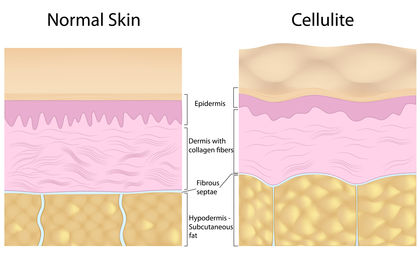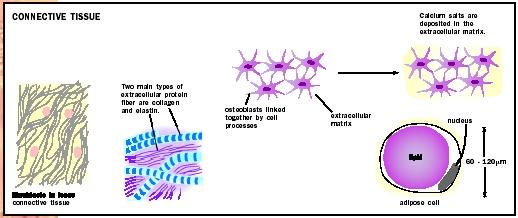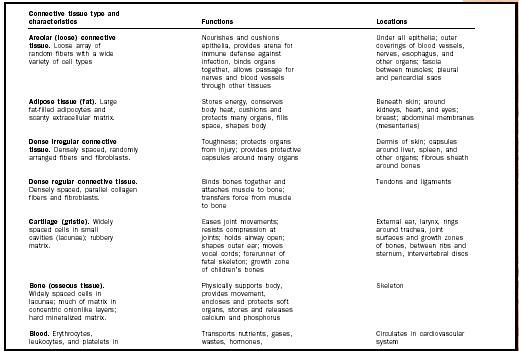Connective Tissue

The human body is composed of just four basic kinds of tissue: nervous, muscular, epithelial, and connective tissue. Connective tissue is the most abundant, widely distributed, and varied type. It includes fibrous tissues, fat, cartilage, bone, bone marrow, and blood. As the name implies, connective tissues often bind other organs together, hold organs in place, cushion them, and fill space.
Connective tissue is distinguished from the other types in that the extracellular material (matrix) usually occupies more space than the cells do, and the cells are relatively far apart. Fat is an exception, having cells in close contact with each other; but with large, nonliving, intracellular lipid droplets, fat contains much more nonliving material than living material.
The matrix of connective tissue typically consists of fibers and a featureless ground substance. The most abundant fiber in connective tissues is a tough protein called collagen. Tendons, ligaments, and the white stringy tissue (fascia) seen in some cuts of meat are composed almost entirely of collagen, as is leather, which consists of the connective tissue layer (dermis) of animal skins. Collagen also strengthens bone and cartilage. Elastic and reticular fibers are less abundant connective tissue proteins with a more limited distribution.
The ground substance may be liquid, as in blood; gelatinous, as in areolar tissue; rubbery, as in cartilage; or calcified and stony, as in bone. It consists mainly of water and small dissolved ions and organic molecules, but the gelatinous to rubbery consistency of some tissues results from enormous protein-carbohydrate complexes in the ground substance. The hard consistency of bone results mainly from calcium phosphate salts in the ground substance.
Some of the cells of connective tissue are fibroblasts (which produce collagen fibers and are the only cell type in tendons and ligaments); adipocytes (fat cells); leukocytes (white blood cells, also found outside the


| Connective tissue type and characteristics | Functions | Locations |
| Areolar (loose) connective tissue. Loose array of random fibers with a wide variety of cell types | Nourishes and cushions epithelia, provides arena for immune defense against infection, binds organs together, allows passage for nerves and blood vessels through other tissues | Under all epithelia; outer coverings of blood vessels, nerves, esophagus, and other organs; fascia between muscles; pleural and pericardial sacs |
| Adipose tissue (fat). Large fat-filled adipocytes and scanty extracellular matrix. | Stores energy, conserves body heat, cushions and protects many organs, fills space, shapes body | Beneath skin; around kidneys, heart, and eyes; breast; abdominal membranes (mesenteries) |
| Dense irregular connective tissue. Densely spaced, randomly arranged fibers and fibroblasts. | Toughness; protects organs from injury; provides protective capsules around many organs | Dermis of skin; capsules around liver, spleen, and other organs; fibrous sheath around bones |
| Dense regular connective tissue. Densely spaced, parallel collagen fibers and fibroblasts. | Binds bones together and attaches muscle to bone; transfers force from muscle to bone | Tendons and ligaments |
| Cartilage (gristle). Widely spaced cells in small cavities (lacunae); rubbery matrix. | Eases joint movements; resists compression at joints; holds airway open; shapes outer ear; moves vocal cords; forerunner of fetal skeleton; growth zone of children's bones | External ear, larynx, rings around trachea, joint surfaces and growth zones of bones, between ribs and sternum, intervertebral discs |
| Bone (osseous tissue). Widely spaced cells in lacunae; much of matrix in concentric onionlike layers; hard mineralized matrix. | Physically supports body, provides movement, encloses and protects soft organs, stores and releases calcium and phosphorus | Skeleton |
| Blood. Erythrocytes, leukocytes, and platelets in | Transports nutrients, gases, wastes, hormones, | Circulates in cardiovascular system |
bloodstream in fibrous connective tissues); macrophages (large phagocytic cells descended from certain leukocytes); erythrocytes (red blood cells, found only in the blood and bone marrow); chondrocytes (cartilage cells); and osteocytes (bone cells).
The table above lists representative locations and functions of the major types of connective tissue. Further details on connective tissue can be found in textbooks of histology and human anatomy.
Kenneth S. Saladin
Bibliography
Gartner, Leslie P., and James L. Hiatt. Color Textbook of Histology. Philadelphia, PA: W. B. Saunders, Co., 1997.
Ross, Michael H., Lynn J. Romrell, and Gordon I. Kaye. Histology: A Text and Atlas, 3rd ed. Philadelphia, PA: Lippincott Williams & Wilkins, 1994.
Saladin, Kenneth S. Anatomy & Physiology: The Unity of Form and Function, 2nd ed. Dubuque, IA: McGraw-Hill Higher Education, 2001.
Comment about this article, ask questions, or add new information about this topic: